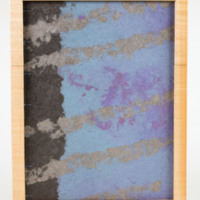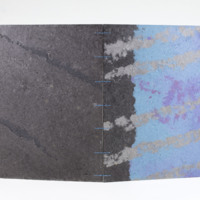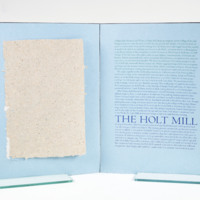A79. Holt Mill Papers
Title
A79. Holt Mill Papers
Creator
Thomas, Peter and Donna
Description
38 x 29 cm (15” x 11 ½”), 11 pages, 50 copies.
Binding: Hand-stitched Coptic binding. Covers are multicolored paper boards, handmade by John Babcock. Copies 1-10 are housed in a wooden picture frame slipcase. Paper: Blue or green, handmade using cotton rag and other fibers by Peter Thomas with the help of Jonna Gibson. Printing: Letterpress. Illustrations by Rigby Graham printed from photoengravings. Typography: Handset Centaur. Illustration: Two samples of paper made by Rigby Graham at the Holt Mill sewn in. Reproductions of five illustrations by Rigby Graham. Copies 1-10 each contain an additional paper sample with a “string painting” made by Donna Thomas "signed with thread initials so that no one would think John Mason produced it".
“As a paper historian and a hand papermaker, I have a genuine interest in documenting the origins of the modern renaissance in hand papermaking. I had read John Mason's Papermaking as an Artistic Craft, and knew the name of Rigby Graham as the illustrator of that book. I also knew he had made paper, for I had read in his contribution to Mason's Twelve by Eight Papers about The Holt Mill, Aylestone. I was in England in 1989 and learned from a book seller that Graham was still living in Leicester. I contacted him and set up a meeting to discuss Mason's Twelve by Eight hand paper mill. Rigby Graham is a natural storyteller as well as a talented artist. That interview has been edited and published as a limited edition book titled, You Can't Make Paper From a Loofa. As our meeting progressed I perceived a seldom recognized fact: Rigby Graham was clearly the first ‘paper artist.’ He pioneered many of the techniques now used in the field and is best known for his string paintings. What impressed me most during the interview was the depth of his artistic involvement in papermaking so early on, and the sense of humor with which he approached his activities.
During our visit he showed me proof sheets of a book titled Holt Mill Papers, which he and Tony Savage had begun to print in 1959. It began with the following introduction: ‘The motley collection of sheets which follows is the result of hours of misguided effort and wasted labour. These have been produced despite a lack of equipment that was infuriating, and complete ignorance of the craft that was quite pitiful. Only three quarters of what follows is true, the remainder is bloody lies.’ When Graham told me that he still had about 100 of the sheets he had made in 1958 as samples for that book, I seized the moment and suggested printing a similar book now. Rigby Graham was excited by the idea and generously agreed to dig through his portfolios to find some drawings of the Holt and to write a text.”
Binding: Hand-stitched Coptic binding. Covers are multicolored paper boards, handmade by John Babcock. Copies 1-10 are housed in a wooden picture frame slipcase. Paper: Blue or green, handmade using cotton rag and other fibers by Peter Thomas with the help of Jonna Gibson. Printing: Letterpress. Illustrations by Rigby Graham printed from photoengravings. Typography: Handset Centaur. Illustration: Two samples of paper made by Rigby Graham at the Holt Mill sewn in. Reproductions of five illustrations by Rigby Graham. Copies 1-10 each contain an additional paper sample with a “string painting” made by Donna Thomas "signed with thread initials so that no one would think John Mason produced it".
“As a paper historian and a hand papermaker, I have a genuine interest in documenting the origins of the modern renaissance in hand papermaking. I had read John Mason's Papermaking as an Artistic Craft, and knew the name of Rigby Graham as the illustrator of that book. I also knew he had made paper, for I had read in his contribution to Mason's Twelve by Eight Papers about The Holt Mill, Aylestone. I was in England in 1989 and learned from a book seller that Graham was still living in Leicester. I contacted him and set up a meeting to discuss Mason's Twelve by Eight hand paper mill. Rigby Graham is a natural storyteller as well as a talented artist. That interview has been edited and published as a limited edition book titled, You Can't Make Paper From a Loofa. As our meeting progressed I perceived a seldom recognized fact: Rigby Graham was clearly the first ‘paper artist.’ He pioneered many of the techniques now used in the field and is best known for his string paintings. What impressed me most during the interview was the depth of his artistic involvement in papermaking so early on, and the sense of humor with which he approached his activities.
During our visit he showed me proof sheets of a book titled Holt Mill Papers, which he and Tony Savage had begun to print in 1959. It began with the following introduction: ‘The motley collection of sheets which follows is the result of hours of misguided effort and wasted labour. These have been produced despite a lack of equipment that was infuriating, and complete ignorance of the craft that was quite pitiful. Only three quarters of what follows is true, the remainder is bloody lies.’ When Graham told me that he still had about 100 of the sheets he had made in 1958 as samples for that book, I seized the moment and suggested printing a similar book now. Rigby Graham was excited by the idea and generously agreed to dig through his portfolios to find some drawings of the Holt and to write a text.”
Publisher
Santa Cruz, California: Peter & Donna Thomas
Date
1994
Language
English
Collection
Appears in Exhibits
Citation
Thomas, Peter and Donna, “A79. Holt Mill Papers,” Digital Exhibits - UWM Libraries Special Collections, accessed November 18, 2025, https://web.uwm.edu/lib-omeka-spc2/items/show/541.



